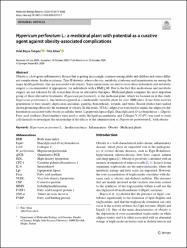| dc.contributor.author | Tokgöz, Hilal Büşra | |
| dc.contributor.author | Altan, Filiz | |
| dc.date.accessioned | 2020-11-20T14:29:58Z | |
| dc.date.available | 2020-11-20T14:29:58Z | |
| dc.date.issued | 2020 | |
| dc.identifier.issn | 0301-4851 | |
| dc.identifier.issn | 1573-4978 | |
| dc.identifier.uri | https://doi.org/10.1007/s11033-020-05912-7 | |
| dc.identifier.uri | https://hdl.handle.net/20.500.12809/282 | |
| dc.description | WOS: 000581562900002 | en_US |
| dc.description | PubMed ID: 33090307 | en_US |
| dc.description.abstract | Obesity is a low-grade inflammatory disease that is getting increasingly common among adults and children and causes different complications. Insulin resistance, Type II diabetes, atherosclerosis, metabolic syndrome and hypertension are among the major health problems, that are associated with obesity. Some medications are used to treat obese individuals and metabolic surgery is recommended, if appropriate, for individuals with a BMI >= 40. Due to the fact that medications and metabolic surgery are not tolerated by all, researchers focus on alternative therapies. Medicinal plants comprise the most important group of these alternative treatments. Hypericum perforatum L. is the medicinal plant, which we focused on in this study. Hypericum perforatum L. has been recognized as a medicinally valuable plant for over 2000 years. It has been used for generations to treat anxiety, depression, insomnia, gastritis, hemorrhoids, wounds, and burns. Recent studies have indeed shown promising effects for the treatment of obesity. In this study, 3T3-L1 adipocytes were used to mimic the adipocyte differentiation associated with obesity in cellular terms. Lipoprotein lipase (Lpl), Diacylglycerol-O-acyltransferase 1 (Dgat1), Fatty acid synthase (Fasn) markers were used to study the lipid accumulation, and Collagen V (ColV) was used to study cell elasticity to investigate the relationship of the effects of the administration of Hypericum perforatum L. with obesity. | en_US |
| dc.description.sponsorship | Scientific Resarch Project (BAP) Grant from the Mula Stk Kocman University [AR-GE 17/059] | en_US |
| dc.description.sponsorship | This work was supported by the Scientific Resarch Project (BAP) Grant (AR-GE 17/059) from the Mula Stk Kocman University granted to Dr. Filiz ALTAN. Authors would like to thank to Dr. Reat uNAL for valuable scientific support and critical reading; to Dr. Zekiye Buket YILMAZ for critical reading and language editing; to Dr. Guven GoRK and Dr. Olcay CEYLAN for providing the plant material and to Dr. Mehmet VAROL for his expertise and assistance in technical editing. | en_US |
| dc.item-language.iso | eng | en_US |
| dc.publisher | Springer | en_US |
| dc.item-rights | info:eu-repo/semantics/openAccess | en_US |
| dc.subject | Hypericum Perforatum L | en_US |
| dc.subject | Insulin Resistance | en_US |
| dc.subject | Inflammation | en_US |
| dc.subject | Obesity | en_US |
| dc.subject | Medicinal Plants | en_US |
| dc.title | Hypericum perforatum L.: a medicinal plant with potential as a curative agent against obesity-associated complications | en_US |
| dc.item-type | article | en_US |
| dc.contributor.department | MÜ,Fen Fakültesi, Moleküler Biyoloji Ve Genetik Bölümü | en_US |
| dc.contributor.institutionauthor | Altan, Filiz | |
| dc.identifier.doi | 10.1007/s11033-020-05912-7 | |
| dc.relation.journal | Molecular Biology Reports | en_US |
| dc.relation.publicationcategory | Makale - Uluslararası Hakemli Dergi - Kurum Öğretim Elemanı | en_US |


















